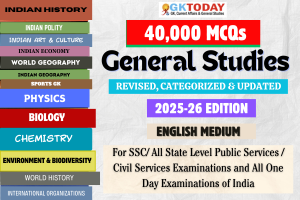Multiple Choice Quiz Questions (MCQs) on Ancient Indian History for General Studies and GK preparation of SSC, NDA, CDS, UPSC, UPPSC and State PSC Examinations.
11. Who among the following was an Indian sage and Guru, reputed to disseminate Tantric Buddhism in Bhutan and Tibet during the 8th century?
[A] Asanga
[B] Nagarjuna
[C] Padmasambhava
[D] Mahavir
Show Answer
Correct Answer: C [Padmasambhava]
Notes:
Padmasambhava, also known as Guru Rinpoche, was an 8th-century Buddhist master from the Indian subcontinent. It is said he brought Vajrayana tantric Buddhism to Tibet and Bhutan and is recognized as the second Buddha in these regions. His name means “Lotus-Born”, as per the legend, by his birth he was miraculously appeared seated lotus. Subsequently, he played a crucial role in the development of Tibetan Buddhism and culture.
12. What is Ettuthokai?
[A] A dynasty during sangam era
[B] A collection of poems
[C] A series of sports plays during Sangam Era
[D] A writing tool during sangam Era
Show Answer
Correct Answer: B [A collection of poems]
Notes:
Ettuthokai is a collection of eight books of classical Tamil poetry. It is part of the Pathinen Melkanakku series, which is a collection of 11 anthologies of songs with more lines. The eight books in Ettuthokai are: Ainkurnuru, Akananuru, Purananuru, Kaliththokai, Kuruntokai, Natrinai, Paripaatal, Pathirruppaththu.
Ettuthokai is part of the Sangam Literature, which is some of the oldest available Tamil literature. It is dated to between 200 BCE and 200 CE.
13. Which among the following is considered to be the official law book of the Guptas?
[A] Manusmriti
[B] Parashara Smriti
[C] Yajnavalkya Smriti
[D] Vyasa Smriti
Show Answer
Correct Answer: C [Yajnavalkya Smriti]
Notes:
Yajnavalkyasmriti, which is almost regarded as the official law book of Guptas, was composed also in Gupta era.
14. Which among the following is correct about Bhaddasala?
[A] He was a poet in the court of Chandragupta Maurya
[B] He was the general of the Nanda Army
[C] He was an ambassador of Ceylon King sent to Asoka’s court
[D] He was a playwright in the Gupta Era
Show Answer
Correct Answer: B [He was the general of the Nanda Army]
Notes:
Bhaddasala – (Bhadra shala / Bhadra shal ) was very strong opponent faced by chandragupta. He was a general of King Nanda.
15. The Hindu and Jain mythology refer to which among the following as the centre of the universe?
[A] Mount Kailas
[B] Ujjain
[C] Mount Meru
[D] Pushkar Lake
Show Answer
Correct Answer: C [Mount Meru]
Notes:
Mount Meru or Sumeru is a sacred five-peaked mountain in the Hindu, Jain, and Buddhist cosmology. It is considered to be the centre of all the physical, metaphysical and spiritual universes.
16. Which of the following is the script of Indus Valley civilization?
[A] Persian
[B] Dravidian
[C] Sanskrit
[D] Undeciphered
Show Answer
Correct Answer: D [Undeciphered]
Notes:
The Indus script is a corpus of symbols produced by the Indus Valley Civilisation. There is no known bilingual inscription to help decipher the script.
17. Which of the following is the preaching mudra associated with the Buddha’s First Sermon at Sarnath?
[A] abhaya
[B] dhyana
[C] dharmachakra
[D] bhumisparsa
Show Answer
Correct Answer: C [dharmachakra]
Notes:
The Buddha’s first sermon is sometimes called the “first turning of the dharma wheel.” Or “dharmachakra”. The sermon, Buddha gave to the five monks, was his first sermon and was called the Dhammacakkappavattana Sutta. It was given on the full-moon day of Asalha Puja. Buddha subsequently also spent his first rainy season at Sarnath at the Mulagandhakuti.
18. Which Harappan pottery is said to be the earliest example of its kind in the world?
[A] Glazed
[B] Knobbed
[C] Perforated
[D] Polychrome
Show Answer
Correct Answer: A [Glazed]
Notes:
The glazed steatite pottery found from Harappan sites is considered the earliest example of glazed pottery in the world. It is thinner than most other pottery and also lacks conventional surface treatment of red slip and buff surface. Instead, a thin layer of silica was fused to the body during the firing process in the kiln, which gave the pottery a smooth, glassy and shiny surface. Their technique of firing pottery reached high levels of sophistication.
19. Who among the following named the Indus valley civilization as the ‘Harappan civilization’ after the name of the Indus site of Harappa?
[A] Dr Sankhalia
[B] Dr S R Rao
[C] Sir ME M Wheeler
[D] Sir John Marshall
Show Answer
Correct Answer: D [Sir John Marshall]
Notes:
Sir John Marshall- Director-General of the ASI from 1902–1928 led to organisation of its work structure and departments. In the 1920s, he named the newly discovered Indus Valley civilization after Harappa, the first site excavated in Sahni’s 1921 work, thus giving the entire culture its nomenclature as the ‘Harappan civilization’.
20. Which of the following tools were used during Early Paleolithic age?
[A] Hand axes and cleavers
[B] Scraper and flakes
[C] Blades and burins
[D] Microliths
Show Answer
Correct Answer: A [Hand axes and cleavers]
Notes:
Tools used in various ages were:
Early Palaeolithic: Hand axes and cleavers
Middle Palaeolithic: Scraper and flakes
Upper Palaeolithic: Blades and burins
Mesolithic: Microliths
 These questions are part of GKToday's 40,000+ GK Questions Course in GKToday Android Application which provides more than 40K questions with explanations suitable for all Competitive Exams of India.
These questions are part of GKToday's 40,000+ GK Questions Course in GKToday Android Application which provides more than 40K questions with explanations suitable for all Competitive Exams of India.
